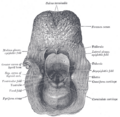Pharynx facts for kids
Quick facts for kids Pharynx |
|
|---|---|
 |
|
| Head and inner neck | |
 |
|
| Pharynx | |
| Latin | pharynx |
| Artery | pharyngeal branches of ascending pharyngeal artery, ascending palatine, descending palatine, pharyngeal branches of inferior thyroid |
| Vein | pharyngeal plexus |
| Nerve | pharyngeal plexus, maxillary nerve, mandibular nerve |
The pharynx is a special part of your throat. It's located right behind your mouth and nose, and it sits above two important tubes: the esophagus, which carries food to your stomach, and the larynx, which leads to your lungs. You can find a pharynx in many animals, not just humans, though its exact shape changes from one species to another.
In humans, the pharynx is a busy pathway. It's a key part of your digestive system, helping food move down. It's also part of the respiratory system, acting as a "conducting zone" for air. This means it helps filter, warm, and moisten the air you breathe before it reaches your lungs. The pharynx also plays a big role in how we make sounds and speak.
Your human pharynx is usually divided into three main sections: the nasopharynx, oropharynx, and laryngopharynx. These sections work together to manage both air and food.
Contents
What the Pharynx Does
The pharynx is like a busy crossroads in your body, managing both the air you breathe and the food you eat. It makes sure that air goes to your lungs and food goes to your stomach, without mixing them up.
Breathing and Airflow
When you breathe in, air travels through your nose or mouth and then enters the pharynx. The pharynx guides this air down towards your larynx and then into your trachea (windpipe), which leads to your lungs. It's part of the "conducting zone" of your respiratory system. This zone includes your nostrils, larynx, trachea, bronchi, and bronchioles. Together, these parts clean, warm, and add moisture to the air before it reaches your lungs.
Digestion and Swallowing
When you eat, food and drinks pass through your pharynx after leaving your mouth. The pharynx helps push the food down into your esophagus, which then carries it to your stomach. Special muscles in the pharynx work to make sure food moves in the right direction and doesn't accidentally go into your windpipe.
Speaking and Sound Production
The pharynx is also very important for making sounds and speaking. As air leaves your lungs and passes through your larynx (voice box), it vibrates your vocal cords. The pharynx then helps to shape these vibrations into the sounds of your voice. Different movements of the pharynx can change the sound, allowing you to make different words and tones.
Parts of the Human Pharynx
The human pharynx is divided into three main sections, each with its own special job:
Nasopharynx
The nasopharynx is the upper part of the pharynx. It's located behind your nose and above the soft part of the roof of your mouth (called the soft palate). This section is mainly for air. It helps to warm and moisten the air you breathe in. It also connects to your ears through tubes called auditory tubes, which help balance air pressure in your ears.
Oropharynx
The oropharynx is the middle part of the pharynx. It's located behind your mouth. Both air and food pass through this section. When you breathe through your mouth, air goes through the oropharynx. When you swallow, food and liquids pass through here on their way to the esophagus. Your tonsils, which are part of your immune system, are also found in this area.
Laryngopharynx
The laryngopharynx (also called the hypopharynx) is the lower part of the pharynx. It's located behind your larynx (voice box) and extends down to where the pathway splits into the esophagus (for food) and the larynx (for air). This section is the final common pathway for both air and food before they go their separate ways. It's very important for directing food into the esophagus and preventing it from entering the windpipe.
Pharynx Muscles
The pharynx has two groups of pharyngeal muscles that help it do its job. These muscles are arranged in layers. There's an inner layer of muscles that run up and down (longitudinal muscles) and an outer layer of muscles that go around in circles (circular muscles). These muscles work together to change the shape of the pharynx, which helps with swallowing and speaking.
Images for kids
-
Pharynx of the flatworm Prorhynchus fontinalis
-
Pharynx of the flatworm Platydemus manokwari visible as the worm feeds on a snail.
-
Longitudinal section through the roundworm Caenorhabditis elegans showing the position of the pharynx in the animal body.
-
Microscopic cross section through the pharynx of a larva from an unknown lamprey species.
See also
 In Spanish: Faringe para niños
In Spanish: Faringe para niños











